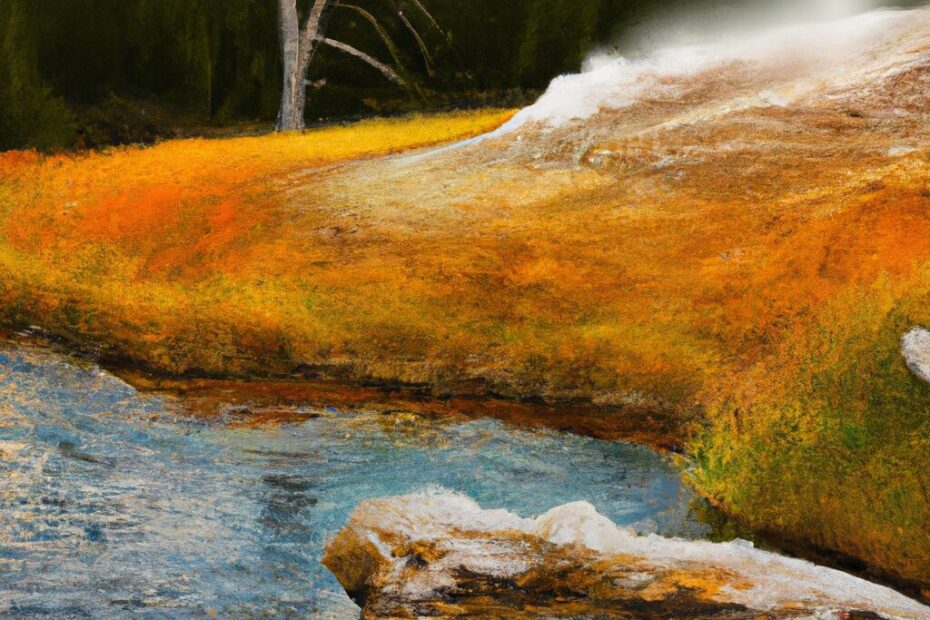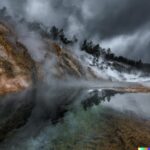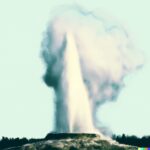If you’re a nature enthusiast or just love witnessing the awe-inspiring power of geothermal activity, then Riverside Geyser is a must-see destination. In this article, we will explore everything you need to know about Riverside Geyser, from its location to its eruption schedule. Discover how often Riverside Geyser erupts, what to expect during an eruption, and the best tips for viewing and photographing this remarkable natural phenomenon. Let’s dive in and uncover the magic of Riverside Geyser!
What Is Riverside Geyser?
Riverside Geyser, located in Yellowstone National Park, is a captivating natural phenomenon known for its geothermal activity and hot spring characteristics.
It is situated along the banks of the picturesque Firehole River, surrounded by a diverse array of geothermal features that make up the unique landscape of the park. The geyser’s eruptions, which can reach heights of up to 75 feet, are a spectacular display of the raw power and beauty of Yellowstone’s geological forces. Visitors are often in awe of the rhythmic spouting of boiling water and steam, which adds to the overall allure of Riverside Geyser as a must-see attraction in the park.
Where Is Riverside Geyser Located?
Riverside Geyser is situated within the picturesque Yellowstone National Park in Wyoming, amidst a landscape rich in geothermal areas and unique geological features.
Flowing through the park, the Firehole River sits adjacent to Riverside Geyser, contributing to the geyser’s awe-inspiring eruptions. The geothermal activity in this region creates a dynamic environment, with colorful hot springs and bubbling mud pots scattered throughout. Yellowstone National Park, known for its vast geothermal wonders, is home to the famous Old Faithful geyser as well as lesser-known gems like Riverside Geyser, offering visitors a glimpse into the Earth’s powerful forces at work.
What Is the Eruption Schedule for Riverside Geyser?
The eruption schedule of Riverside Geyser, like other geysers in the park, follows specific intervals between eruptions, creating a predictable yet awe-inspiring natural display.
This consistency in timing is a product of the underlying geothermal activity that fuels these incredible phenomena. Riverside Geyser tends to erupt approximately every 6 hours, making it a prime attraction for visitors eager to witness its powerful jets of water and steam shooting high into the air. By studying these patterns and comparing them to other geysers in Yellowstone National Park, geologists and park rangers can better predict when these breathtaking displays are likely to occur, enhancing the overall visitor experience.
How Often Does Riverside Geyser Erupt?
Riverside Geyser erupts at regular intervals, with the frequency of its eruptions being a subject of interest for geological researchers and predictive models.
Many studies have been conducted to understand the patterns of Riverside Geyser’s eruptions, revealing that on average, it erupts every 5.5 to 7 hours. This consistent timing has piqued the curiosity of scientists seeking to develop more accurate predictive models.
Recent research has shown correlations between seismic activity and the geyser’s eruptions, providing valuable insights into the factors influencing its behavior. By studying these eruption patterns, researchers aim to enhance their ability to forecast when Riverside Geyser will next unleash its magnificent display of natural power.
What Time of Day Does Riverside Geyser Erupt?
The timings of Riverside Geyser’s eruptions are meticulously monitored using advanced equipment to determine the specific time of day when the geyser is most likely to erupt.
This monitoring process involves the utilization of high-tech thermal imaging cameras that capture the temperature changes in the geyser’s vent area, providing valuable data on the build-up of pressure and imminent eruptions. Seismic monitoring instruments are strategically placed around the geyser to detect even the slightest underground movements, aiding in predicting the eruption timings with remarkable accuracy. By combining the insights from these sophisticated monitoring technologies, researchers and geologists can effectively pinpoint the windows of peak activity for Riverside Geyser, enhancing our understanding of its natural rhythms.
What Is the Average Duration of a Riverside Geyser Eruption?
A Riverside Geyser eruption is a spectacular sight to behold, with the average duration of these thermal features capturing the attention of visitors and nature enthusiasts.
Witnessing the eruption of Riverside Geyser, one is immediately drawn in by the natural spectacle unfolding before them. As the geyser shoots hot water and steam high into the air, the shimmering mist glows in the sunlight, creating a mesmerizing display. The eruption can last anywhere from 20 to 30 minutes, allowing ample time to admire the raw power and beauty of this geothermal wonder. The distinct aroma of sulfur fills the air, adding to the sensory experience of being in the presence of such a dynamic thermal phenomenon.
Are There Any Predictors for Riverside Geyser Eruptions?
Efforts to predict Riverside Geyser eruptions involve analyzing various factors such as the heat source, pressure buildup, and other geothermal indicators to anticipate the timing of future eruptions.
Researchers rely on sophisticated predictive models that take into account the dynamic interplay between heat sources beneath the geyser, fluctuations in pressure within the geothermal system, and key indicators like water level changes and steam emissions. By closely monitoring these factors, scientists can establish patterns and trends that help them forecast the likelihood of an eruption with greater accuracy. Understanding the underlying mechanisms behind geyser eruptions is crucial for developing reliable prediction methods that can benefit both scientific research and public safety measures.
What Can You Expect to See During a Riverside Geyser Eruption?
During a Riverside Geyser eruption, visitors are treated to a mesmerizing display of steam, towering water columns, and boiling water, reminiscent of volcanic activity and the release of pressure through steam vents.
The steam rises in swirling tendrils, creating an eerie yet captivating ambiance around the geyser basin. As the water reaches its boiling point, the pressure builds underneath, culminating in a powerful explosion of hot water shooting skyward. The towering water columns glisten in the sunlight, refracting colors like a prism amidst the billowing steam clouds. The forceful release of water evokes a primal energy, showcasing nature’s raw power in action, a geological symphony orchestrated by the Earth itself.
What Is the Height of the Eruption?
The eruption of Riverside Geyser can reach impressive heights, with the water column showcasing varying eruptive behaviors that captivate onlookers with each display.
These eruptions can soar up to 75 feet or more in the air, creating a spectacular sight against the backdrop of the surrounding thermal features. The dynamic nature of the water column adds an element of unpredictability to each eruption, with some bursts shooting straight up while others twist and dance in the wind.
The bursts can last for several minutes, with the geyser’s energy building up before propelling the water high into the sky. This dynamic display highlights the interconnectedness of geothermal activity and showcases the powerful forces at work beneath the Earth’s surface.
What Type of Eruptions Does Riverside Geyser Have?
Riverside Geyser is known for its hydrothermal explosions during eruptions, creating a spectacle that underscores the geyser’s association with thermal springs and geothermal activities.
These explosive eruptions are a result of the intense pressure building up within the geyser’s underground chambers, caused by the superheated water and steam. As Riverside Geyser reaches its boiling point, the water bursts forth in a dramatic display, shooting high into the air. This type of eruption is categorized as a hydrothermal explosion, characterized by the sudden release of steam and water, accompanied by a thunderous roar that reverberates through the surrounding geothermal landscape. The mesmerizing interplay of forces at work showcases nature’s raw power and the intricate dance of geothermal phenomena.
Are There Any Unique Features of Riverside Geyser Eruptions?
The eruptions of Riverside Geyser showcase unique geological features tied to its underground reservoir dynamics, with distinct emission patterns contributing to its mesmerizing displays.
These underground reservoirs play a vital role in shaping the eruptions of Riverside Geyser, influencing the temperature and mineral content of the water expelled during its powerful displays.
The geyser’s emission patterns are characterized by impressive bursts of steam and water propelled high into the air, creating a spectacle that attracts visitors from far and wide.
The interaction between the geyser’s underground reservoirs and the surrounding geological formations results in a harmonious dance of natural forces, showcasing the raw power and beauty of this captivating natural wonder.
How Can You Best View a Riverside Geyser Eruption?
Experiencing a Riverside Geyser eruption at the Upper Geyser Basin can be best enjoyed during certain times of the year when the geyser’s display is at its peak, attracting tourists with its boiling water and natural beauty.
During the peak season from late spring to early fall, visitors have the greatest chance of witnessing the impressive spectacle of Riverside Geyser shooting water up to 75 feet high. Spring offers a unique charm with blooming wildflowers, while the vivid colors of fall create a picturesque backdrop.
Winter, although enchanting with snow-covered landscapes, might not be the ideal time to catch the geyser in action due to the harsh weather conditions. Thus, planning a visit during the warmer months ensures a memorable geyser viewing experience.
What Is the Best Time of Year to Visit Riverside Geyser?
The best time of year to visit Riverside Geyser and Yellowstone National Park is influenced by factors such as precipitation patterns and groundwater interactions that impact the geyser’s activity levels and accessibility for visitors.
While spring and early summer bring ample precipitation to the park, resulting in heightened activity of Riverside Geyser due to increased groundwater levels, fall showcases a different beauty with colorful foliage surrounding the geothermal features.
Winter, on the other hand, offers a unique experience with the geyser steaming against a snow-covered backdrop, although accessibility may be limited due to road closures.
Visitors planning their trip should consider these seasonal variations to make the most of their visit to this mesmerizing natural wonder.
Are There Any Tips for Photographing Riverside Geyser Eruptions?
Photographing Riverside Geyser eruptions can be enhanced through the use of thermal imaging technology and geothermal exploration equipment, allowing photographers to capture the geyser’s activity with precision and detail.
By utilizing thermal imaging tools, photographers can tap into the infrared spectrum to detect temperature differences, making it easier to predict when the geyser will erupt.
Geothermal exploration gear such as seismic sensors can help in monitoring subtle shifts in the geyser’s behavior, providing valuable insights for positioning the perfect shot.
Incorporating advanced monitoring equipment like time-lapse cameras can capture the gradual build-up to the eruption, adding a dynamic element to the final photograph.
These tools elevate geyser photography to a whole new level, enabling photographers to showcase nature’s wonders in a captivating way.
Last Updated on February 11, 2024 by Jon Waraas – Originally Posted: February 11, 2024

I’m Jon Waraas, and I’ve been navigating the online world since 2006. By day, I’m the proud owner of some eCommerce gems, and by night, I’m the voice behind the adventures on Waraas.Com.
My heart, however, belongs to the wild beauty of Yellowstone National Park. I’ve got a collection of websites dedicated to sharing the wonders of this natural masterpiece. Oh, and did I mention? I’m currently building my own cabin inside the ghost town of Gilmore, Idaho – a cabin with tales to tell!
When I’m not immersed in the digital realm, you’ll find me lacing up my boots for a good hike or setting up camp under the star-studded sky.




